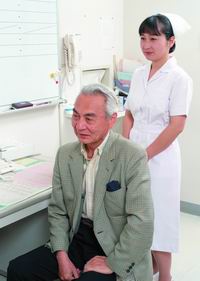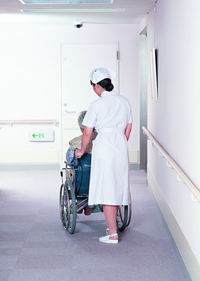
The medicare system of China was the best in the world before the 1980s. But the once prevailing rural Medicare system gradually faded during the 1980s, when rural economic reform took place.
The Medicare System of China in Rural Areas Need Improving
“The Medicare system of China was the best in the world before the 1980s,”Wang Meigang, a researcher of Health Economy Graduate School under the Ministry of Health, sighed.“This is not bragging. This is a comment from a foreigner.”
According to Wang, former general secretary Doctor Muller came to China several times to study China’s Medicare system and put forward that China was worth using as a reference for the rest of the world. Wang said that this showed that there were some thoughts and ideas in our past medicare system that were worth maintaining and extending, such as the ideas of fulfilling people’s basic needs, emphasizing grass roots action and the spreading of feasible techniques.
Muller came to China and showed that the medicare system in the west, which is characterized by hi-tech equipment, high inputs and high costs, did not answer everyone’s problems. From the medical angle, it is not necessary to rely entirely on hi-tech equipment and high cost treatments to maintain people’s health. From an economic point-of-view, the key point is“risk sharing”.
In the era of China's planned economy, the government provided urban residents with welfare "from the cradle to the grave," including health care. Before China’s reform and opening to the outside, the Medicare system mainly consisted of Socialized Medicine, Labor Insurance Medicine, and Cooperative Medical Service in the Countryside. It covered almost all the Chinese. Along with the enhancement of economic reforms and the establishment of the market economy, many problems occurred.
The overuse of Socialized Medicine created a great burden for the country and individual companies. While in the countryside, since the Household Contract Responsibility System with Remuneration Linked to Output was carried out in 1983, along with the development of the Collective Economy and the collapse of the Cooperative Medical Service in the Countryside, cooperative medical service only covered 4.8 percent of the countryside in 1989, while it covered 90 percent in 1976.
Owing to the austere situation of the medicare system, China began to carry out Medicare system reform for townsmen in Zhenjiang, Jiangsu province, and Jiujiang, Jianxi province in 1994 and extended it nationwide in 1999. As to the vast rural area, the state health conference in 1996 decided that cooperative medical services were still the best choice for China. Chinese government issued in May 2001 an instruction on the reform and development of the rural health care system requiring the establishment of a medical service network to adapt to reform of the economic system and social development in rural areas. The goal is to help rural residents have easy access to primary health care services.
  In China, 900 million rural people, accounting for 70 percent of the population, share just 20 percent of the nation's medical resources such as hospitals and doctors. Now, roughly 80 percent of hospitals and doctors are concentrated in cities and about two-thirds of senior doctors and high-tech equipment in big hospitals. Some remote, rural areas still suffer from a severe shortage of hospitals and medical practitioners. In China, 900 million rural people, accounting for 70 percent of the population, share just 20 percent of the nation's medical resources such as hospitals and doctors. Now, roughly 80 percent of hospitals and doctors are concentrated in cities and about two-thirds of senior doctors and high-tech equipment in big hospitals. Some remote, rural areas still suffer from a severe shortage of hospitals and medical practitioners.
An increasing number of rural residents are victims of "unfairness" while receiving medical services, because they have no money to visit doctors. The rocketing price of medical service is the main health care worry for many farmers as the income gap in urban and rural areas continues to widen.
A study by the Ministry of Health indicated that in 1998, 37 percent of all ill farmers did not visit the doctor, and 65 percent of patients who should have been hospitalized failed to receive treatment simply because they were unable to pay.
"Local authorities should take practical measures to promote basic reforms in China's medicare system in the countryside and provide rural residents with better medical treatment," Vice-Minister of Health Peng Yu said.
Aiming to provide basic medical service to 900 million residents in vast rural areas, China has begun to streamline a health care network that was brought to the verge of collapse in the past decade.
The network, based on state-funded medical centers in rural towns and villages, will also be composed of private hospitals and clinics with trained staff and standard services.
 More farmers will be able to afford medical services if they join the pool system, known as "cooperative medical service," which collects funds from individuals, collectively-owned businesses and governments. More farmers will be able to afford medical services if they join the pool system, known as "cooperative medical service," which collects funds from individuals, collectively-owned businesses and governments.
"It is very important and urgent to establish an affordable and effective network of primary health care in rural areas," said Zhang Wenkang, the country's health minister.
Central government's plan: The State Council, China's cabinet, has mapped out a plan of reform aiming to improve medical services in rural areas. Local governments are allowed to conduct different trials.
"Our aim is to set up a system to provide basic services for treatment, disease prevention and health promotion for every farmer," Zhang said.
The work will focus on the control of infectious diseases and the prevention of non-infectious chronic illnesses such as tumors and diabetes.
Special attention is to be paid to health care for children, women and the elderly, as well as to the improvement of drinking water and sanitation.
Medical workers in rural areas are required to conduct health education activities to promote awareness of healthy lifestyles.
The central government is formulating policies for the management of township hospitals, investment in the rural health care sector and the training of countryside doctors, to regulate the service.
Statistics show that more than 700,000 former collectively- sponsored clinics have been transformed to individually-owned ones since 1990. The uncontrolled price increase of medicines and the spread of fake or low-quality medicines, indulged by loose governmental supervision, placed barriers to poor farmersshavingstheir diseases cured.
Realizing the incompatible coexistence of the current rural medicare system and the health demands among China's 900 million farmers, more and more rural governments at different levels began to explore various ways, including reforms of investment, personnel management and income distribution systems, to build up a more reasonable medical service system.
A recent national instruction on the reform and development of the rural medical system requires more investment in the field and encourages the development of the newly emerged mechanism.
Under the guideline, China's rural medical reform is expected to enter a new phase of all-round advancement, running on a clear and practical track, analysts predicted, and the dream that all Chinese farmers will no longer fear getting sick and will be able to afford medical fees is expected to come true soon.
Background
China created a three-level rural health care system in 1958: namely Socialized Medicine, Labor Insurance Medicine, and Cooperative Medical Services. The collective economy at that time offered financial support to all the clinics stationed in villages, communes (townships) and counties while the farmers did not need to pay for medical services. During the period barefoot doctors were created to provide health care to people in isolated areas.
China's three-level system won acknowledgment from international health care organizations for its success in spreading medical services to millions of rural people at a low cost.
But the once prevailing rural medicare system gradually faded in the 1980s, when the rural economic reform took place. Without the financial backup from the collective economy, poor villages could not afford the cost of running clinics, and farmers could not enjoy the welfare of free medical services any longer.
In 1991, China began to try out the old-age insurance system in some of the rural areas. The basic principle for the rural old-age insurance system is that the premiums are to be paid mainly by the beneficiaries themselves, supplemented by collectively pooled subsidy and supported by government policies, the accumulation of funds taking the form of personal accounts.
In 1988, the Chinese government began to reform the free medicare system in government institutions and the labor protection medicare system in state-owned enterprises. In 1998, the government issued the Decision on Establishing the Basic Medical Insurance System for Urban Employees, enforcing a basic medical insurance system for urban employees throughout the country. In July of 2000 and 2001, the State Council held conferences again and emphasized that the reform of medical insurance, medical institutions and the medicine circulating system should be enforced simultaneously.
| ![]() 本网站由北京信息港提供网络支持
本网站由北京信息港提供网络支持


 In China, 900 million rural people, accounting for 70 percent of the population, share just 20 percent of the nation's medical resources such as hospitals and doctors. Now, roughly 80 percent of hospitals and doctors are concentrated in cities and about two-thirds of senior doctors and high-tech equipment in big hospitals. Some remote, rural areas still suffer from a severe shortage of hospitals and medical practitioners.
In China, 900 million rural people, accounting for 70 percent of the population, share just 20 percent of the nation's medical resources such as hospitals and doctors. Now, roughly 80 percent of hospitals and doctors are concentrated in cities and about two-thirds of senior doctors and high-tech equipment in big hospitals. Some remote, rural areas still suffer from a severe shortage of hospitals and medical practitioners. More farmers will be able to afford medical services if they join the pool system, known as "cooperative medical service," which collects funds from individuals, collectively-owned businesses and governments.
More farmers will be able to afford medical services if they join the pool system, known as "cooperative medical service," which collects funds from individuals, collectively-owned businesses and governments.